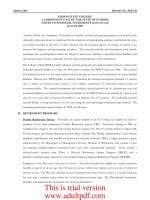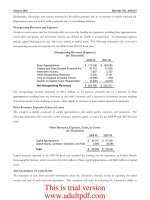REPORT NO. 2010-138 MARCH 2010 EDISON STATE COLLEGE _part5 potx
Bạn đang xem bản rút gọn của tài liệu. Xem và tải ngay bản đầy đủ của tài liệu tại đây (250.4 KB, 9 trang )
MARCH 2010 REPORT NO. 2010-138
EDISON STATE COLLEGE
A COMPONENT UNIT OF THE STATE OF FLORIDA
NOTES TO FINANCIAL STATEMENTS (C
ONTINUED)
J
UNE 30, 2009
33
Actuarial Methods and Assumptions. Projections of benefits for financial reporting purposes are based on the
substantive plan provisions, as understood by the employer and participating members, and include the types
of benefits provided at the time of each valuation and the historical pattern of sharing of benefit costs
between the employer and participating members. The actuarial methods and assumptions used include
techniques that are designed to reduce the effects of short-term volatility in actuarial accrued liabilities and
the actuarial value of assets, consistent with the long-term perspective of the calculations.
The College’s initial OPEB actuarial valuation used the projected unit credit actuarial method to estimate the
unfunded actuarial liability as of June 30, 2009, and to estimate the 2008-09 fiscal year ARC. This method
was selected because it is the same method used in the private sector for determination of retiree medical
liabilities. Because the OPEB liability is currently unfunded, the actuarial assumptions included a 3 percent
rate of return on invested assets, which is the College’s expectation of investment returns under its
investment policy. The actuarial assumptions also included a payroll growth rate of 3 percent per year, and
an annual healthcare cost trend rate of 8 percent initially for the 2008-09 fiscal year, reduced by 1 percent per
year for two years, then 0.5 percent thereafter, to an ultimate rate of 5 percent. The unfunded actuarial
accrued liability is being amortized over 30 years using the level percentage of projected pay method. The
remaining amortization period at June 30, 2009, was 28 years.
10. RETIREMENT PROGRAMS
Florida Retirement System
. Essentially all regular employees of the College are eligible to enroll as
members of the State-administered Florida Retirement System (FRS). Provisions relating to FRS are
established by Chapters 121 and 122, Florida Statutes; Chapter 112, Part IV, Florida Statutes; Chapter 238,
Florida Statutes; and Florida Retirement System Rules, Chapter 60S, Florida Administrative Code; wherein
eligibility, contributions, and benefits are defined and described in detail. FRS is a single retirement system
administered by the Department of Management Services, Division of Retirement, and consists of two
cost-sharing, multiple-employer retirement plans and other nonintegrated programs. These include a
defined-benefit pension plan (Plan), a Deferred Retirement Option Program (DROP), and a
defined-contribution plan, referred to as the Public Employee Optional Retirement Program (PEORP).
Employees in the Plan vest at six years of service. All vested members are eligible for normal retirement
benefits at age 62 or at any age after 30 years of service, which may include up to 4 years of credit for
military service. The Plan also includes an early retirement provision; however, there is a benefit reduction
for each year a member retires before his or her normal retirement date. The Plan provides retirement,
disability and death benefits and annual cost-of-living adjustments.
This is trial version
www.adultpdf.com
MARCH 2010 REPORT NO. 2010-138
EDISON STATE COLLEGE
A COMPONENT UNIT OF THE STATE OF FLORIDA
NOTES TO FINANCIAL STATEMENTS (C
ONTINUED)
J
UNE 30, 2009
34
DROP, subject to provisions of Section 121.091, Florida Statutes, permits employees eligible for normal
retirement under the Plan to defer receipt of monthly benefit payments while continuing employment with
an FRS employer. An employee may participate in the DROP for a period not to exceed 60 months after
electing to participate. During the period of DROP participation, deferred monthly benefits are held in the
FRS Trust Fund and accrue interest.
The State of Florida establishes contribution rates for participating employers. Contribution rates during the
2008-09 fiscal year were as follows:
Class Percent of Gross Salary
Employee Employer
(A)
Florida Retirement System, Regular 0.00 9.85
Florida Retirement System, Senior Management Service 0.00 13.12
Deferred Retirement Option Program - Applicable to
Members from All of the Above Classes 0.00 10.91
Florida Retirement System, Reemployed Retiree (B) (B)
Notes: (A)
(B)
Employer rates include 1.11 percent for the postemployment health
insurance subsidy. Also, employer rates, other than for DROP
participants, include .05 percent for administrative costs of the Public
Employee Optional Retirement Program.
Contribution rates are dependent upon retirement class in which
reemployed.
The College’s liability for participation is limited to the payment of the required contribution at the rates and
frequencies established by law on future payrolls of the College. The College’s contributions for the fiscal
years ended June 30, 2007, June 30, 2008, and June 30, 2009, totaled $1,417,151, $1,481,522, and $1,487,906,
respectively, which were equal to the required contributions for each fiscal year.
As provided in Section 121.4501, Florida Statutes, eligible FRS members may elect to participate in the
PEORP in lieu of the FRS defined-benefit plan. College employees already participating in the State College
System Optional Retirement Program or the DROP are not eligible to participate in this program. Employer
contributions are defined by law, but the ultimate benefit depends in part on the performance of investment
funds. The PEORP is funded by employer contributions that are based on salary and membership class
(Regular Class, Senior Management Service Class, etc.). Contributions are directed to individual member
accounts, and the individual members allocate contributions and account balances among various approved
investment choices. Employees in PEORP vest at one year of service. There were 129 College participants
during the 2008-09 fiscal year. Required contributions made to the PEORP totaled $451,072.
This is trial version
www.adultpdf.com
MARCH 2010 REPORT NO. 2010-138
EDISON STATE COLLEGE
A COMPONENT UNIT OF THE STATE OF FLORIDA
NOTES TO FINANCIAL STATEMENTS (C
ONTINUED)
J
UNE 30, 2009
35
Financial statements and other supplementary information of the FRS are included in the State’s
Comprehensive Annual Financial Report, which is available from the Florida Department of Financial
Services. An annual report on the FRS, which includes its financial statements, required supplementary
information, actuarial report, and other relevant information, is available from the Florida Department of
Management Services, Division of Retirement.
State College System Optional Retirement Program
. Section 1012.875, Florida Statutes, provides for an
Optional Retirement Program (Program) for eligible college instructors and administrators. The Program is
designed to aid colleges in recruiting employees by offering more portability to employees not expected to
remain in the FRS for six or more years.
The Program is a defined-contribution plan, which provides full and immediate vesting of all contributions
submitted to the participating companies on behalf of the participant. Employees in eligible positions can
make an irrevocable election to participate in the Program, rather than the FRS, and purchase retirement and
death benefits through contracts provided by certain insurance carriers. The employing college contributes,
on behalf of the participant, 10.43 percent of the participant’s salary, less a small amount used to cover
administrative costs. The remaining contribution is invested in the company or companies selected by the
participant to create a fund for the purchase of annuities at retirement. The participant may contribute, by
payroll deduction, an amount not to exceed the percentage contributed by the college to the participant’s
annuity account.
There were 32 College participants during the 2008-09 fiscal year. Required employer contributions made to
the Program totaled $229,127.
Senior Management Local Annuity Optional Retirement Program
. Effective July 1, 1991, the Board
approved the adoption of an optional retirement plan under Section 121.055, Florida Statutes. Pursuant to
the Statute, members of the Senior Management Service Class of the Florida Retirement System may make
an irrevocable election to withdraw from the Florida Retirement System and participate in a Local Annuity
Plan. The Plan complies with Section 403(b) of the Internal Revenue Code.
The College contributes an amount equal to a percentage of the participant’s salary to an annuity plan
provided by approved sponsors. The Board approves the College’s contribution percentage rate each year.
The participant does not make any contributions to the Plan. Each participant is fully vested immediately.
During the 2008-09 fiscal year, there were four Plan participants, and the College contributed $114,473 to
the Local Annuity Plan.
This is trial version
www.adultpdf.com
MARCH 2010 REPORT NO. 2010-138
EDISON STATE COLLEGE
A COMPONENT UNIT OF THE STATE OF FLORIDA
NOTES TO FINANCIAL STATEMENTS (C
ONTINUED)
J
UNE 30, 2009
36
11. OTHER TERMINATION BENEFITS
The College provides an IRS approved Code Section 401(a) pre-tax program for termination pay that
permits the College to disburse termination pay in a tax-advantaged manner for both the College and the
employee. Contributions are limited by IRS regulation. All employees in designated employee classes with
at least 10 years of service at the time of separation are mandated to participate in this program. The College
deferred $317,787 in salaries for 13 employees during the 2008-09 fiscal year for the other termination
benefits.
12. SAVINGS INCENTIVE PLAN
Effective January 1, 1994, the Board approved the adoption of a Savings Incentive Plan as provided by
Section 403(b) of the Internal Revenue Code of 1986. Under the Plan, all full-time employees can elect to
defer a portion of their salary within Internal Revenue Service guidelines. The College may make a matching
employer contribution in an amount to be determined annually by the Board at its discretion. During the
2008-09 fiscal year, the College matched one dollar for every dollar up to the first three percent of employee
compensation. Each employee is fully vested upon enrollment in the Plan, and is allowed to direct the
investment of his or her account to any one of the various fund groups and insurance companies approved
for investment by the College. During the 2008-09 fiscal year, the College contributed $378,063 as matching
funds under the Plan.
13. CONSTRUCTION COMMITMENTS
The College’s major construction commitments at June 30, 2009, are as follows:
Project Description Total Completed Balance
Commitment to Date Committed
Nursing Building - Lee Campus:
Construction Manager 12,981,527$ 937,195$ 12,044,332$
Architect 1,240,765 911,106 329,659
Direct Materials 1,440,919 44,078 1,396,841
Rush Library - Lee Campus:
Construction Manager 5,688,992 5,556,055 132,937
Architect 390,311 388,588 1,723
Total
21,742,514$ 7,837,022$ 13,905,492$
14. OPERATING LEASE COMMITMENTS
The College rents office equipment and computers under operating leases, which expire on various dates
through the year 2012. These leased assets and the related commitments are not reported on the College’s
This is trial version
www.adultpdf.com
MARCH 2010 REPORT NO. 2010-138
EDISON STATE COLLEGE
A COMPONENT UNIT OF THE STATE OF FLORIDA
NOTES TO FINANCIAL STATEMENTS (C
ONTINUED)
J
UNE 30, 2009
37
statement of net assets. Operating lease payments are recorded as expenses when paid or incurred.
Outstanding commitments resulting from these lease agreements are contingent upon future appropriations.
Future minimum lease commitments for noncancelable operating leases are as follows:
Fiscal Year Ending June 30 Amount
2010 211,420$
2011 140,607
2012 95,504
Total Minimum Payments Required
447,531$
15. RISK MANAGEMENT PROGRAMS
The College is exposed to various risks of loss related to torts; theft of, damage to, and destruction of assets;
errors and omissions; injuries to employees; and natural disasters. The College provided coverage for these
risks primarily through the Florida College System Risk Management Consortium (Consortium), which was
created under authority of Section 1001.64(27), Florida Statutes, by the boards of trustees of the Florida
public colleges for the purpose of joining a cooperative effort to develop, implement, and participate in a
coordinated Statewide college risk management program. The Consortium is self-sustaining through
member assessments (premiums) and is reinsured through commercial companies for claims in excess of
specified amounts. Reinsurance from commercial companies provided excess coverage of up to
$200 million through February 28, 2009, and up to $175 million effective March 1, 2009. Insurance coverage
obtained through the Consortium included health and hospitalization, dental, life, fire and extended
property, general and automobile liability, workers’ compensation, and other liability coverage. Settled
claims resulting from these risks have not exceeded coverage in any of the past three fiscal years.
16. SCHEDULE OF STATE REVENUE SOURCES
Revenue from State sources for current operations is primarily from the College Program Fund administered
by the Florida Department of Education under the provisions of Section 1011.81, Florida Statutes. In
accordance with Section 1011.84, Florida Statutes, the Legislature determines each college’s apportionment
considering the following components: base budget, which includes the State appropriation to the College
Program Fund in the current year plus the related student tuition and fees assigned in the current General
Appropriations Act; the cost-to-continue allocation, which consists of incremental changes to the base
budget, including salaries, price levels, and other related costs; enrollment workload adjustments; operation
costs of new facilities adjustments; and new and improved program enhancements, which are determined by
the Legislature. Student fees in the base budget plus student fee revenues generated by increases in fee rates
This is trial version
www.adultpdf.com
MARCH 2010 REPORT NO. 2010-138
EDISON STATE COLLEGE
A COMPONENT UNIT OF THE STATE OF FLORIDA
NOTES TO FINANCIAL STATEMENTS (C
ONTINUED)
J
UNE 30, 2009
38
are deducted from the sum of these components to determine the net annual State apportionment to each
college.
The State allocates gross receipts taxes, generally known as Public Education Capital Outlay money, to the
College on an annual basis. The College is authorized to receive and expend these resources only upon
applying for and receiving an encumbrance authorization from the Florida Department of Education.
The following is a summary of State revenue sources and amounts:
Source Amount
Gross Receipts Tax (Public Education Capital Outlay) 22,887,805$
College Program Fund 20,909,687
2,990,463
Bright Futures Scholarship Program 1,995,526
Florida Student Assistance Grants 806,454
Motor Vehicle License Tax (Capital Outlay and Debt Service) 335,981
Other State Sources 195,953
Baccalaureate Program 185,748
Total
50,307,617$
Education Enhancement Trust Fund (Lottery)
17. FUNCTIONAL DISTRIBUTION OF OPERATING EXPENSES
The functional classification of an operating expense (instruction, academic support, etc.) is assigned to a
department based on the nature of the activity, which represents the material portion of the activity
attributable to the department. For example, activities of an academic department for which the primary
departmental function is instruction may include some activities other than direct instruction such as public
service. However, when the primary mission of the department consists of instructional program elements,
all expenses of the department are reported under the instruction classification. The operating expenses on
the statement of revenues, expenses, and changes in net assets are presented by natural classifications. The
following are those same expenses presented in functional classifications as recommended by NACUBO:
This is trial version
www.adultpdf.com
MARCH 2010 REPORT NO. 2010-138
EDISON STATE COLLEGE
A COMPONENT UNIT OF THE STATE OF FLORIDA
NOTES TO FINANCIAL STATEMENTS (C
ONTINUED)
J
UNE 30, 2009
39
Functional Classification Amount
Instruction 21,137,662$
Public Services 312
Academic Support 6,032,028
Student Services 6,073,442
Institutional Support 11,334,100
Operation and Maintenance of Plant 8,856,353
Scholarships and Fellowships 8,158,651
Depreciation 3,719,284
Auxiliary Enterprises 348,509
Total Operating Expenses
65,660,341$
This is trial version
www.adultpdf.com
MARCH 2010 REPORT NO. 2010-138
40
AUDITOR GENERAL
STATE OF FLORIDA
G74 Claude Pepper Building
111 West Madison Street
Tallahassee, Florida 32399-1450
The President of the Senate, the Speaker of the
House of Representatives, and the
Legislative Auditing Committee
INDEPENDENT AUDITOR’S REPORT ON INTERNAL CONTROL OVER
FINANCIAL REPORTING AND ON COMPLIANCE AND OTHER MATTERS
BASED ON AN AUDIT OF THE FINANCIAL STATEMENTS PERFORMED
IN ACCORDANCE WITH
GOVERNMENT AUDITING STANDARDS
We have audited the financial statements of Edison State College, a component unit of the State of Florida, and its
discretely presented component unit as of and for the fiscal year ended June 30, 2009, which collectively comprise the
College’s basic financial statements, and have issued our report thereon included under the heading
INDEPENDENT AUDITOR’S REPORT ON FINANCIAL STATEMENTS. Our report on the financial
statements was modified to include a reference to other auditors. We conducted our audit in accordance with auditing
standards generally accepted in the United States of America and the standards applicable to financial audits contained
in Government Auditing Standards issued by the Comptroller General of the United States. Other auditors audited the
financial statements of the discretely presented component unit as described in our report on the College’s financial
statements. This report does not include the results of the other auditors’ testing of internal control over financial
reporting or compliance and other matters that are reported on separately by those auditors.
Internal Control Over Financial Reporting
In planning and performing our audit, we considered the College’s internal control over financial reporting as a basis
for designing our auditing procedures for the purpose of expressing our opinions on the financial statements, but not
for the purpose of expressing an opinion on the effectiveness of the College’s internal control over financial reporting.
Accordingly, we do not express an opinion on the effectiveness of the College’s internal control over financial
reporting.
DAVID W. MARTIN, CP
A
AUDITOR GENERAL
PHONE: 850-488-5534
F
AX: 850-488-6975
This is trial version
www.adultpdf.com
MARCH 2010 REPORT NO. 2010-138
41
A control deficiency exists when the design or operation of a control does not allow management or employees, in the
normal course of performing their assigned functions, to prevent or detect misstatements on a timely basis. A
significant deficiency is a control deficiency, or combination of control deficiencies, that adversely affects the College’s
ability to initiate, authorize, record, process, or report financial data reliably in accordance with generally accepted
accounting principles such that there is more than a remote likelihood that a misstatement of the College’s financial
statements that is more than inconsequential will not be prevented or detected by the College’s internal control.
A material weakness is a significant deficiency, or combination of significant deficiencies, that results in more than a
remote likelihood that a material misstatement of the financial statements will not be prevented or detected by the
College’s internal control.
Our consideration of internal control over financial reporting was for the limited purpose described in the first
paragraph of this section and would not necessarily identify all deficiencies in internal control that might be significant
deficiencies or material weaknesses. We did not identify any deficiencies in internal control over financial reporting
that we consider to be material weaknesses, as defined above.
Compliance and Other Matters
As part of obtaining reasonable assurance about whether the College’s financial statements are free of material
misstatement, we performed tests of its compliance with certain provisions of laws, rules, regulations, contracts, and
grant agreements, noncompliance with which could have a direct and material effect on the determination of financial
statement amounts. However, providing an opinion on compliance with those provisions was not an objective of our
audit and, accordingly, we do not express such an opinion. The results of our tests disclosed no instances of
noncompliance or other matters that are required to be reported under Government Auditing Standards.
We noted certain operational matters that we reported to College management in our report No. 2010-040.
Pursuant to Section 11.45(4), Florida Statutes, this report is a public record and its distribution is not limited.
Auditing standards generally accepted in the United States of America require us to indicate that this report is
intended solely for the information and use of the Legislative Auditing Committee, members of the Florida Senate
and the Florida House of Representatives, Federal and other granting agencies, and applicable management and is not
intended to be and should not be used by anyone other than these specified parties.
Respectfully submitted,
David W. Martin, CPA
March 15, 2010
This is trial version
www.adultpdf.com









